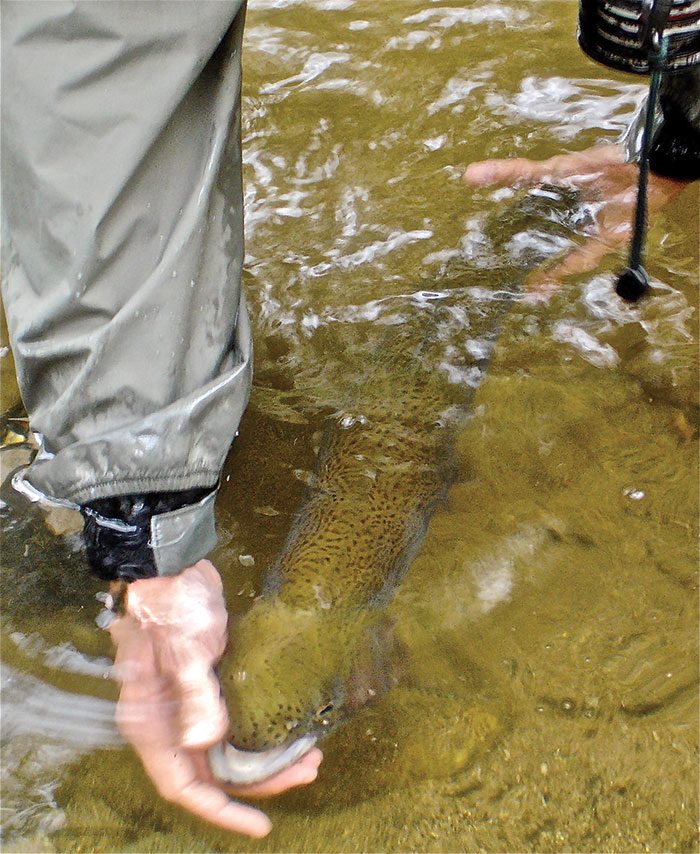By Dustin Stanberry:
With the sport of fishing growing and more anglers on the water, there seems to be more information available. All of this information, paired with the quick access to it using smartphones and social media avenues, can make us a lot more productive on the water. Becoming a better angler is great, but it could all be in vain unless we do our best to protect the resources we so greatly love. Knowing how to safely handle and release fish is just as important as being able to catch fish. Below are a few tips that will help any angler become a better steward of the water.
Tip 1: Minimize the time taken to fight the fish.
There are scenarios that require lighter line or tippet. More often than not, this leads to fish being broken off, but if not, this can be the cause of undue stress on the fish. In general, the lighter the line or tippet, the longer it takes to land the fish. Just like humans, fish build up lactic acid during a fight. If not revived properly, this can lead to an injured or dead fish. Using the heaviest pound test possible for your particular situation can minimize the time it takes to land a fish and can have a huge impact on the health of the fish when released.
Tip 2: Always handle fish with a wet hand.
Virtually all species of fish are covered with a protective mucus membrane. This membrane does quite a few things for the fish. It allows the fish to move through the water with less drag, but more importantly, it protects the fish from diseases, fungi and parasites. Handling a fish with a dry hand removes this protective barrier, and the fish becomes highly susceptible to waterborne diseases and parasites. Wetting your hands before handling the fish will help prevent the removal of the membrane. With this in mind, a net with a rubber bag can be a great tool for the job. Using a net to cradle fish while removing the hook will greatly reduce the possibility of injury to the fish. We will still need to use wet hands to handle the fish, but minimizing contact can be crucial.
Tip 3: Properly reviving the fish before it is released is the next step in safely handling fish.
Regardless of species, all fish need to be revived until able to swim away under their own power. The best way to do this is to place the fish in the water facing into the current and firmly, but not squeezing, hold the fish by the base of the tail until it can swim away on its own. Letting go after a good kick of the tail under the assumption that the fish is ready can lead to the demise of the fish. If the water is cold, you need to be ready to keep your hands submerged until the fish is ready. I wear wool gloves most of the winter when fishing. I take the gloves off to handle the fish and replace them once the fish is released. This is also the reason I like a jacket with good water-tight cuffs.
Tip 4: Correctly holding fish, especially large fish, can be especially important.
Never squeeze a fish. If the fish seems unruly, try turning the fish upside down. This will disrupt their equilibrium and give you a moment to handle the fish without struggle. When it comes to handling trout, you never want to “lip” the fish. This practice may be acceptable for bass, but even bass can be injured this way. Cradling trout and other fish with two hands is the best method. A great way to hold fish is one hand firmly gripping the base of the tail and the other hand supporting the fish from underneath toward the head. Be sure to keep your fingers out of the gills. Handling a fish by the gills can cause serious injury and will usually lead to a delayed mortality.
Tip 5: Hold the fish close to the water.
This way, if the fish struggles, it will only fall a minimal distance. Dropping a fish even a short distance to the water can cause serious injury and possibly death. Keeping the fish in the water until the moment of the photo is also critical. It is a good idea to walk through the operation of a camera with the other anglers in your party. This way, if there is any question about how to operate the device, it is taken care of beforehand.
Tip 6: Know when to leave the hook embedded.
At some point every angler will be faced with this decision: do I cut the line or try to remove the hook? Generally, if you are asking this question, the line should be cut. If the hook is embedded too deep or around the gill area, it’s generally best to cut the line. In most cases, fish have a greater chance of survival expelling the hook on their own as opposed to the angler digging around and trying to remove it.
Tip 7: De-barb your hooks.
There are benefits to de-barbing fish hooks. One of the most important is it’s easier to remove from the fish. Yes, if we de-barb the hook, it is easier for the fish to throw the hook. It requires more line management and skill to keep the fish connected. Another benefit to de-barbing is that in the event you foul hook yourself or another angler, it is easier to remove.
These are just a few tips to handling fish safely. Hopefully you find them helpful and I can assure you that the fish will appreciate your knowledge.

